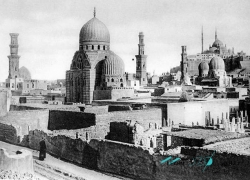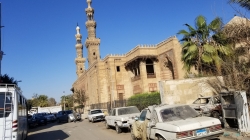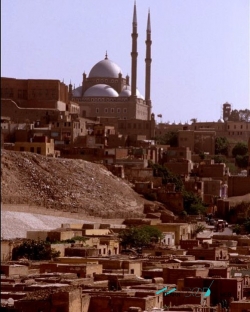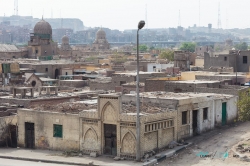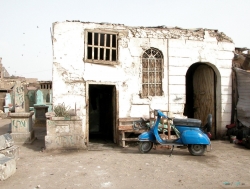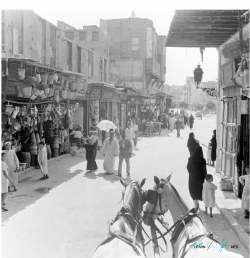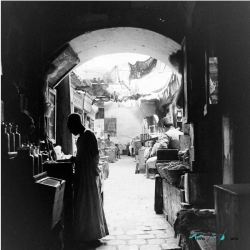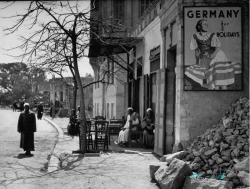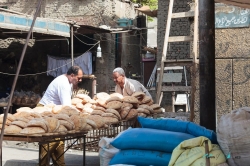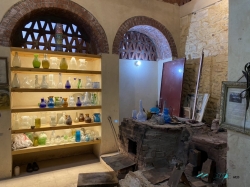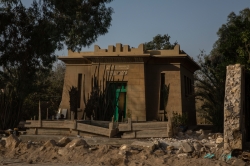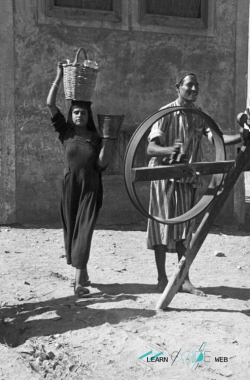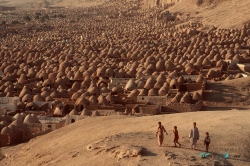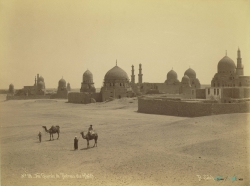The City of the Dead, or Cairo Necropolis, also referred to as the Qarafa (Arabic: القرافة, romanized: al-Qarafa; locally pronounced as al-'arafa), is a series of vast Islamic-era necropolises and cemeteries in Cairo, Egypt. They extend to the north and to the south of the Cairo Citadel, below the Mokattam Hills and outside the historic city walls, covering an area roughly 4 miles long. They are included in the UNESCO World Heritage Site of "Historic Cairo".
The necropolis is separated roughly into two regions: the Northern Cemetery to the north of the Citadel (also called the Eastern Cemetery or Qarafat ash-sharq in Arabic because it is east of the old city walls), and the older Southern Cemetery to the south of the Citadel. There is also another smaller cemetery north of Bab al-Nasr.
The necropolis that makes up "the City of the Dead" has been developed over many centuries and contains both the graves of Cairo's common population as well as the elaborate mausoleums of many of its historical rulers and elites. It started with the early city of Fustat (founded in 642 CE) and arguably reached its apogee, in terms of prestige and monumentality, during the Mamluk era (13th-15th centuries). Throughout their history, the necropolises were home to various types of living inhabitants as well. These included the workers whose professions were tied to the cemeteries (e.g. gravediggers, tomb custodians), the Sufis and religious scholars studying in the religious complexes built by sultans and other wealthy patrons, and the regular inhabitants of small urban settlements and villages in the area. This population grew and shrank according to circumstances in different eras. However, starting in the late 19th century and increasing in the 20th century, the pressure of Cairo's intensive urbanization and its ensuing housing shortage led to a large increase in the number of people living in the necropolis zones. Some people resorted to squatting within the mausoleums and tomb enclosures and turning them into improvised housing; however, these "tomb-dwellers" remained a small fraction of the overall population in the area. This phenomenon led to much media commentary and popular imagination about the condition of those living in the necropolises, linking them symbolically to Cairo's much-discussed overpopulation problems and sometimes leading to exaggerated estimates of the number of people squatting in the mausoleums.[
The necropolis is separated roughly into two regions: the Northern Cemetery to the north of the Citadel (also called the Eastern Cemetery or Qarafat ash-sharq in Arabic because it is east of the old city walls), and the older Southern Cemetery to the south of the Citadel. There is also another smaller cemetery north of Bab al-Nasr.
The necropolis that makes up "the City of the Dead" has been developed over many centuries and contains both the graves of Cairo's common population as well as the elaborate mausoleums of many of its historical rulers and elites. It started with the early city of Fustat (founded in 642 CE) and arguably reached its apogee, in terms of prestige and monumentality, during the Mamluk era (13th-15th centuries). Throughout their history, the necropolises were home to various types of living inhabitants as well. These included the workers whose professions were tied to the cemeteries (e.g. gravediggers, tomb custodians), the Sufis and religious scholars studying in the religious complexes built by sultans and other wealthy patrons, and the regular inhabitants of small urban settlements and villages in the area. This population grew and shrank according to circumstances in different eras. However, starting in the late 19th century and increasing in the 20th century, the pressure of Cairo's intensive urbanization and its ensuing housing shortage led to a large increase in the number of people living in the necropolis zones. Some people resorted to squatting within the mausoleums and tomb enclosures and turning them into improvised housing; however, these "tomb-dwellers" remained a small fraction of the overall population in the area. This phenomenon led to much media commentary and popular imagination about the condition of those living in the necropolises, linking them symbolically to Cairo's much-discussed overpopulation problems and sometimes leading to exaggerated estimates of the number of people squatting in the mausoleums.[



